Legal and Ethical Issues | Report
VerifiedAdded on 2022/09/18
|10
|2722
|97
AI Summary
Contribute Materials
Your contribution can guide someone’s learning journey. Share your
documents today.
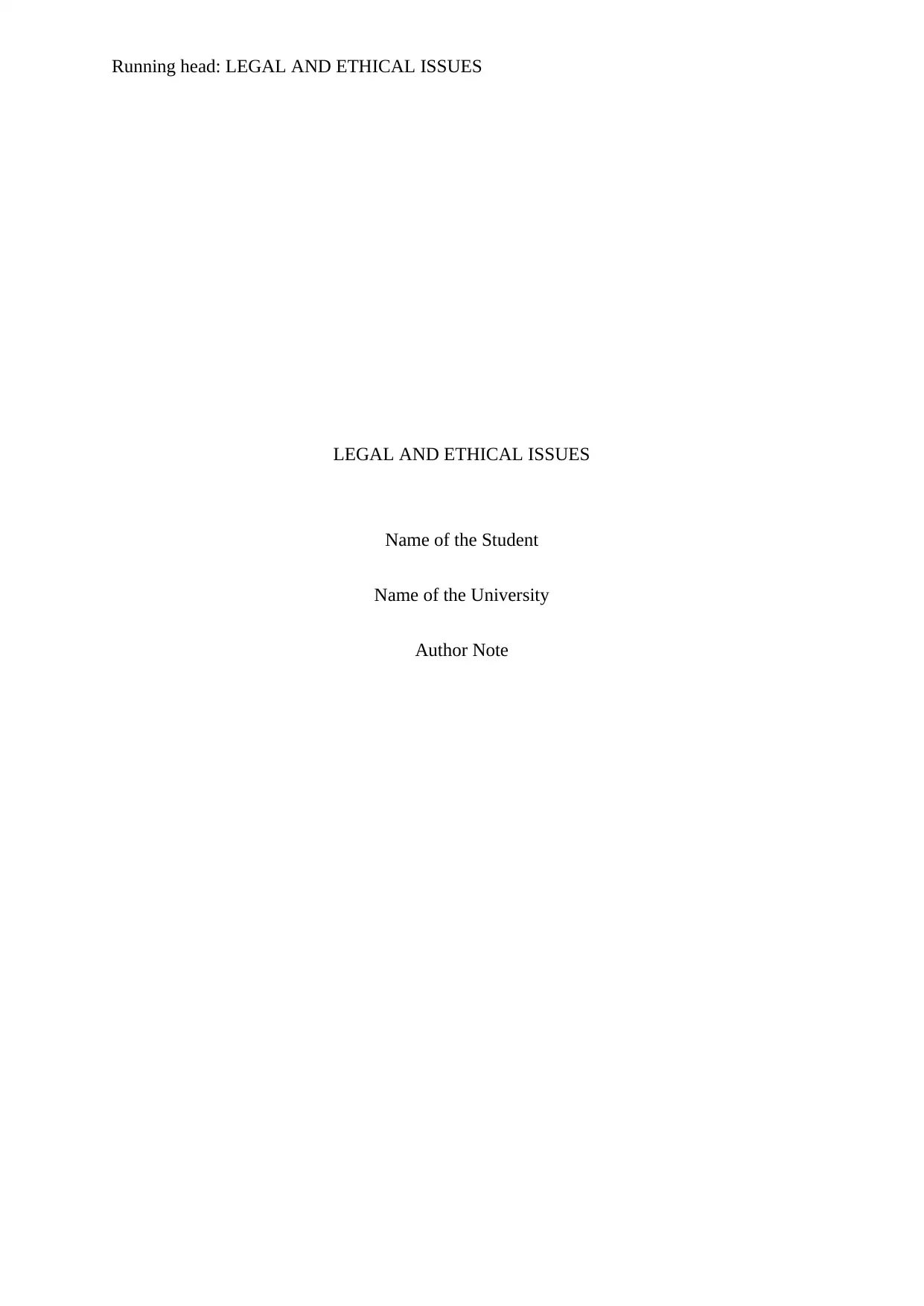
Running head: LEGAL AND ETHICAL ISSUES
LEGAL AND ETHICAL ISSUES
Name of the Student
Name of the University
Author Note
LEGAL AND ETHICAL ISSUES
Name of the Student
Name of the University
Author Note
Secure Best Marks with AI Grader
Need help grading? Try our AI Grader for instant feedback on your assignments.
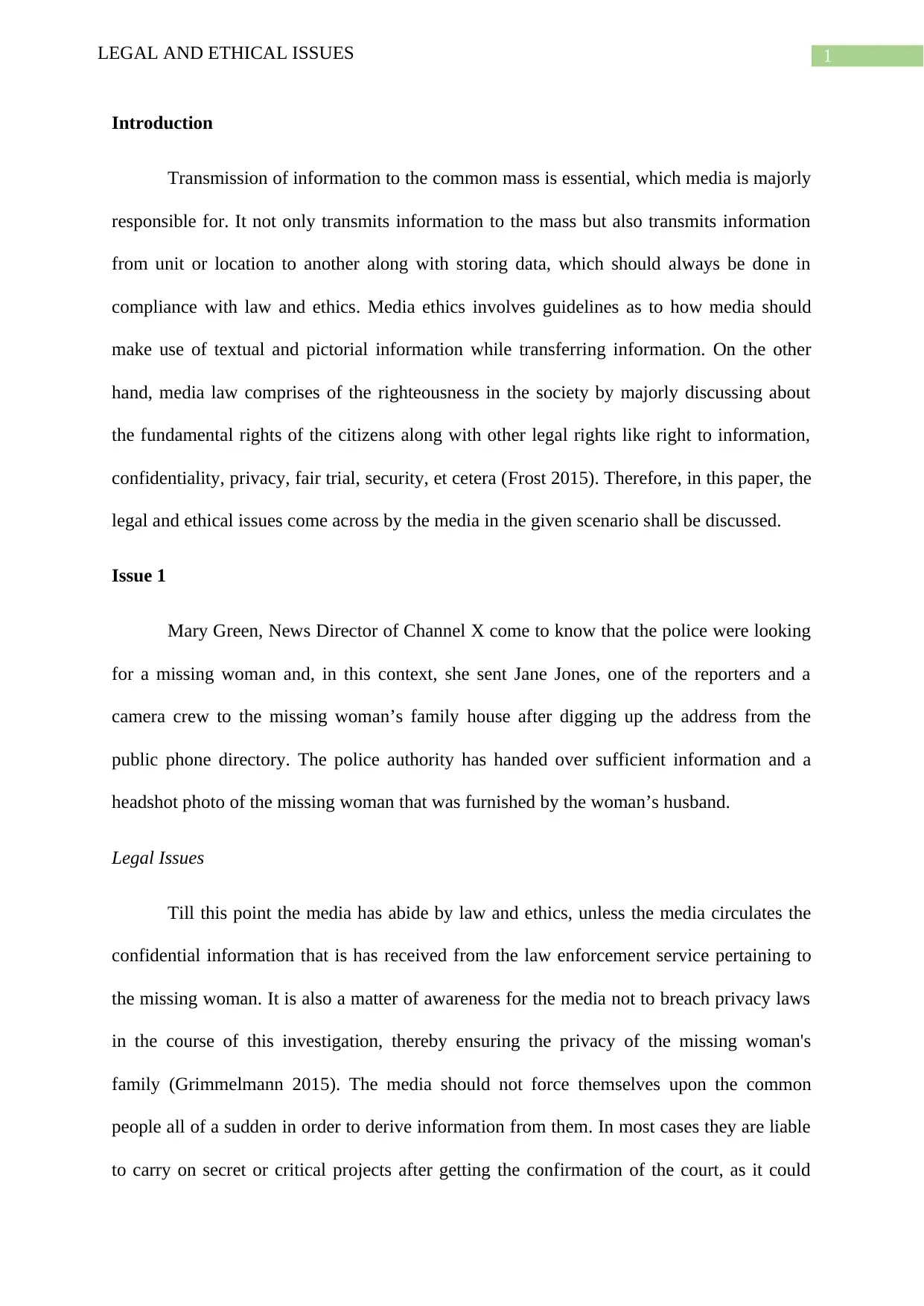
1LEGAL AND ETHICAL ISSUES
Introduction
Transmission of information to the common mass is essential, which media is majorly
responsible for. It not only transmits information to the mass but also transmits information
from unit or location to another along with storing data, which should always be done in
compliance with law and ethics. Media ethics involves guidelines as to how media should
make use of textual and pictorial information while transferring information. On the other
hand, media law comprises of the righteousness in the society by majorly discussing about
the fundamental rights of the citizens along with other legal rights like right to information,
confidentiality, privacy, fair trial, security, et cetera (Frost 2015). Therefore, in this paper, the
legal and ethical issues come across by the media in the given scenario shall be discussed.
Issue 1
Mary Green, News Director of Channel X come to know that the police were looking
for a missing woman and, in this context, she sent Jane Jones, one of the reporters and a
camera crew to the missing woman’s family house after digging up the address from the
public phone directory. The police authority has handed over sufficient information and a
headshot photo of the missing woman that was furnished by the woman’s husband.
Legal Issues
Till this point the media has abide by law and ethics, unless the media circulates the
confidential information that is has received from the law enforcement service pertaining to
the missing woman. It is also a matter of awareness for the media not to breach privacy laws
in the course of this investigation, thereby ensuring the privacy of the missing woman's
family (Grimmelmann 2015). The media should not force themselves upon the common
people all of a sudden in order to derive information from them. In most cases they are liable
to carry on secret or critical projects after getting the confirmation of the court, as it could
Introduction
Transmission of information to the common mass is essential, which media is majorly
responsible for. It not only transmits information to the mass but also transmits information
from unit or location to another along with storing data, which should always be done in
compliance with law and ethics. Media ethics involves guidelines as to how media should
make use of textual and pictorial information while transferring information. On the other
hand, media law comprises of the righteousness in the society by majorly discussing about
the fundamental rights of the citizens along with other legal rights like right to information,
confidentiality, privacy, fair trial, security, et cetera (Frost 2015). Therefore, in this paper, the
legal and ethical issues come across by the media in the given scenario shall be discussed.
Issue 1
Mary Green, News Director of Channel X come to know that the police were looking
for a missing woman and, in this context, she sent Jane Jones, one of the reporters and a
camera crew to the missing woman’s family house after digging up the address from the
public phone directory. The police authority has handed over sufficient information and a
headshot photo of the missing woman that was furnished by the woman’s husband.
Legal Issues
Till this point the media has abide by law and ethics, unless the media circulates the
confidential information that is has received from the law enforcement service pertaining to
the missing woman. It is also a matter of awareness for the media not to breach privacy laws
in the course of this investigation, thereby ensuring the privacy of the missing woman's
family (Grimmelmann 2015). The media should not force themselves upon the common
people all of a sudden in order to derive information from them. In most cases they are liable
to carry on secret or critical projects after getting the confirmation of the court, as it could
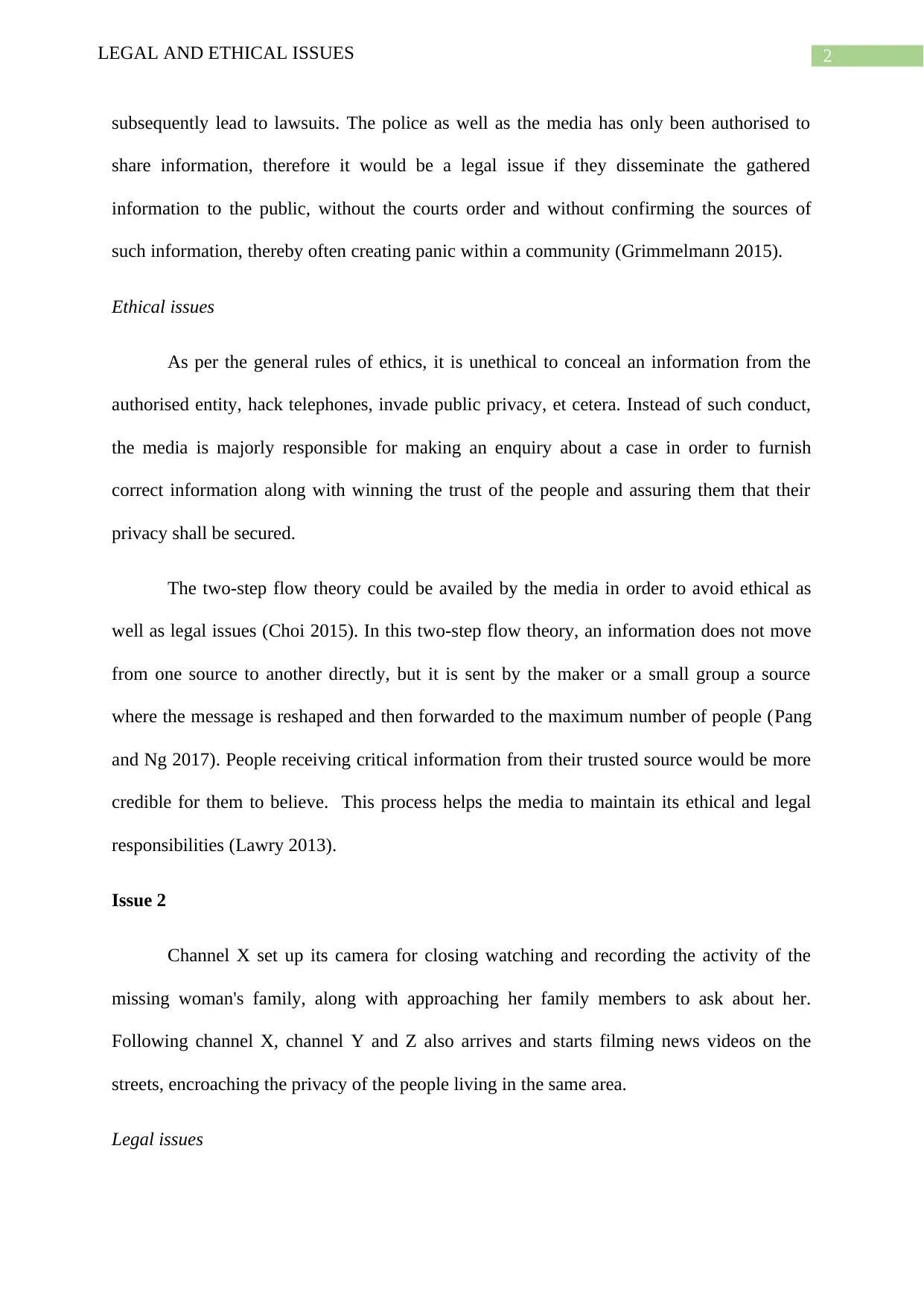
2LEGAL AND ETHICAL ISSUES
subsequently lead to lawsuits. The police as well as the media has only been authorised to
share information, therefore it would be a legal issue if they disseminate the gathered
information to the public, without the courts order and without confirming the sources of
such information, thereby often creating panic within a community (Grimmelmann 2015).
Ethical issues
As per the general rules of ethics, it is unethical to conceal an information from the
authorised entity, hack telephones, invade public privacy, et cetera. Instead of such conduct,
the media is majorly responsible for making an enquiry about a case in order to furnish
correct information along with winning the trust of the people and assuring them that their
privacy shall be secured.
The two-step flow theory could be availed by the media in order to avoid ethical as
well as legal issues (Choi 2015). In this two-step flow theory, an information does not move
from one source to another directly, but it is sent by the maker or a small group a source
where the message is reshaped and then forwarded to the maximum number of people (Pang
and Ng 2017). People receiving critical information from their trusted source would be more
credible for them to believe. This process helps the media to maintain its ethical and legal
responsibilities (Lawry 2013).
Issue 2
Channel X set up its camera for closing watching and recording the activity of the
missing woman's family, along with approaching her family members to ask about her.
Following channel X, channel Y and Z also arrives and starts filming news videos on the
streets, encroaching the privacy of the people living in the same area.
Legal issues
subsequently lead to lawsuits. The police as well as the media has only been authorised to
share information, therefore it would be a legal issue if they disseminate the gathered
information to the public, without the courts order and without confirming the sources of
such information, thereby often creating panic within a community (Grimmelmann 2015).
Ethical issues
As per the general rules of ethics, it is unethical to conceal an information from the
authorised entity, hack telephones, invade public privacy, et cetera. Instead of such conduct,
the media is majorly responsible for making an enquiry about a case in order to furnish
correct information along with winning the trust of the people and assuring them that their
privacy shall be secured.
The two-step flow theory could be availed by the media in order to avoid ethical as
well as legal issues (Choi 2015). In this two-step flow theory, an information does not move
from one source to another directly, but it is sent by the maker or a small group a source
where the message is reshaped and then forwarded to the maximum number of people (Pang
and Ng 2017). People receiving critical information from their trusted source would be more
credible for them to believe. This process helps the media to maintain its ethical and legal
responsibilities (Lawry 2013).
Issue 2
Channel X set up its camera for closing watching and recording the activity of the
missing woman's family, along with approaching her family members to ask about her.
Following channel X, channel Y and Z also arrives and starts filming news videos on the
streets, encroaching the privacy of the people living in the same area.
Legal issues
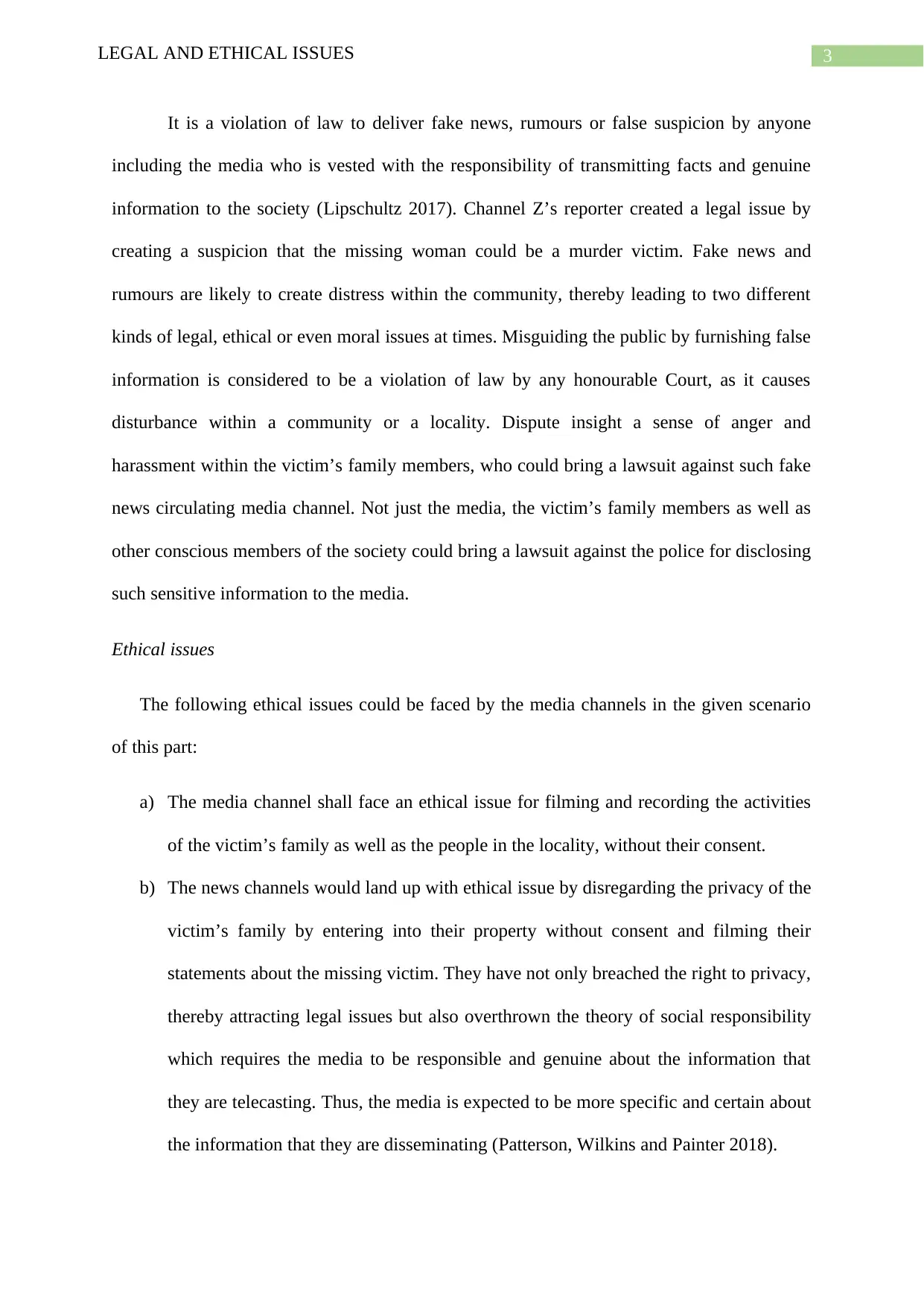
3LEGAL AND ETHICAL ISSUES
It is a violation of law to deliver fake news, rumours or false suspicion by anyone
including the media who is vested with the responsibility of transmitting facts and genuine
information to the society (Lipschultz 2017). Channel Z’s reporter created a legal issue by
creating a suspicion that the missing woman could be a murder victim. Fake news and
rumours are likely to create distress within the community, thereby leading to two different
kinds of legal, ethical or even moral issues at times. Misguiding the public by furnishing false
information is considered to be a violation of law by any honourable Court, as it causes
disturbance within a community or a locality. Dispute insight a sense of anger and
harassment within the victim’s family members, who could bring a lawsuit against such fake
news circulating media channel. Not just the media, the victim’s family members as well as
other conscious members of the society could bring a lawsuit against the police for disclosing
such sensitive information to the media.
Ethical issues
The following ethical issues could be faced by the media channels in the given scenario
of this part:
a) The media channel shall face an ethical issue for filming and recording the activities
of the victim’s family as well as the people in the locality, without their consent.
b) The news channels would land up with ethical issue by disregarding the privacy of the
victim’s family by entering into their property without consent and filming their
statements about the missing victim. They have not only breached the right to privacy,
thereby attracting legal issues but also overthrown the theory of social responsibility
which requires the media to be responsible and genuine about the information that
they are telecasting. Thus, the media is expected to be more specific and certain about
the information that they are disseminating (Patterson, Wilkins and Painter 2018).
It is a violation of law to deliver fake news, rumours or false suspicion by anyone
including the media who is vested with the responsibility of transmitting facts and genuine
information to the society (Lipschultz 2017). Channel Z’s reporter created a legal issue by
creating a suspicion that the missing woman could be a murder victim. Fake news and
rumours are likely to create distress within the community, thereby leading to two different
kinds of legal, ethical or even moral issues at times. Misguiding the public by furnishing false
information is considered to be a violation of law by any honourable Court, as it causes
disturbance within a community or a locality. Dispute insight a sense of anger and
harassment within the victim’s family members, who could bring a lawsuit against such fake
news circulating media channel. Not just the media, the victim’s family members as well as
other conscious members of the society could bring a lawsuit against the police for disclosing
such sensitive information to the media.
Ethical issues
The following ethical issues could be faced by the media channels in the given scenario
of this part:
a) The media channel shall face an ethical issue for filming and recording the activities
of the victim’s family as well as the people in the locality, without their consent.
b) The news channels would land up with ethical issue by disregarding the privacy of the
victim’s family by entering into their property without consent and filming their
statements about the missing victim. They have not only breached the right to privacy,
thereby attracting legal issues but also overthrown the theory of social responsibility
which requires the media to be responsible and genuine about the information that
they are telecasting. Thus, the media is expected to be more specific and certain about
the information that they are disseminating (Patterson, Wilkins and Painter 2018).
Secure Best Marks with AI Grader
Need help grading? Try our AI Grader for instant feedback on your assignments.
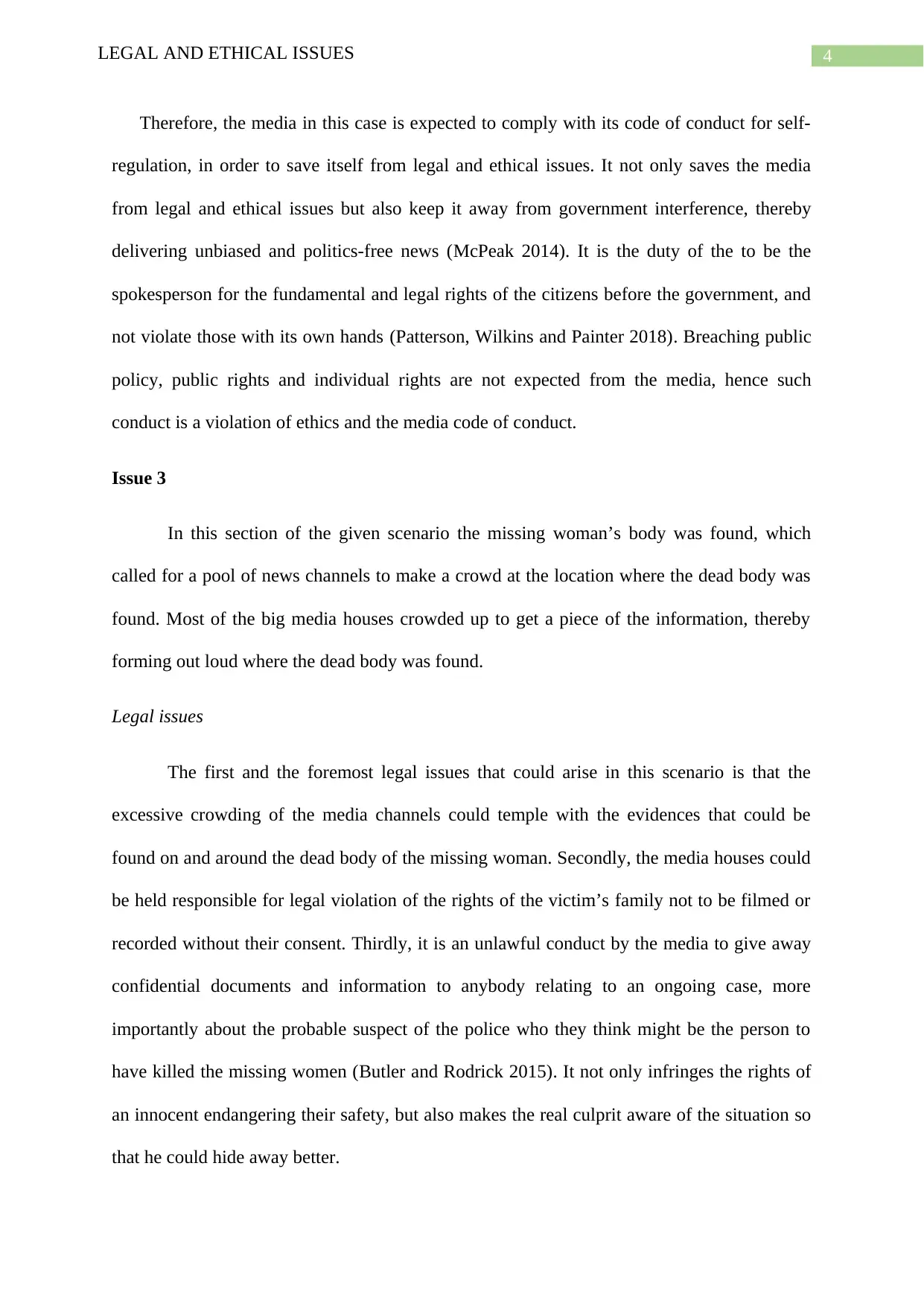
4LEGAL AND ETHICAL ISSUES
Therefore, the media in this case is expected to comply with its code of conduct for self-
regulation, in order to save itself from legal and ethical issues. It not only saves the media
from legal and ethical issues but also keep it away from government interference, thereby
delivering unbiased and politics-free news (McPeak 2014). It is the duty of the to be the
spokesperson for the fundamental and legal rights of the citizens before the government, and
not violate those with its own hands (Patterson, Wilkins and Painter 2018). Breaching public
policy, public rights and individual rights are not expected from the media, hence such
conduct is a violation of ethics and the media code of conduct.
Issue 3
In this section of the given scenario the missing woman’s body was found, which
called for a pool of news channels to make a crowd at the location where the dead body was
found. Most of the big media houses crowded up to get a piece of the information, thereby
forming out loud where the dead body was found.
Legal issues
The first and the foremost legal issues that could arise in this scenario is that the
excessive crowding of the media channels could temple with the evidences that could be
found on and around the dead body of the missing woman. Secondly, the media houses could
be held responsible for legal violation of the rights of the victim’s family not to be filmed or
recorded without their consent. Thirdly, it is an unlawful conduct by the media to give away
confidential documents and information to anybody relating to an ongoing case, more
importantly about the probable suspect of the police who they think might be the person to
have killed the missing women (Butler and Rodrick 2015). It not only infringes the rights of
an innocent endangering their safety, but also makes the real culprit aware of the situation so
that he could hide away better.
Therefore, the media in this case is expected to comply with its code of conduct for self-
regulation, in order to save itself from legal and ethical issues. It not only saves the media
from legal and ethical issues but also keep it away from government interference, thereby
delivering unbiased and politics-free news (McPeak 2014). It is the duty of the to be the
spokesperson for the fundamental and legal rights of the citizens before the government, and
not violate those with its own hands (Patterson, Wilkins and Painter 2018). Breaching public
policy, public rights and individual rights are not expected from the media, hence such
conduct is a violation of ethics and the media code of conduct.
Issue 3
In this section of the given scenario the missing woman’s body was found, which
called for a pool of news channels to make a crowd at the location where the dead body was
found. Most of the big media houses crowded up to get a piece of the information, thereby
forming out loud where the dead body was found.
Legal issues
The first and the foremost legal issues that could arise in this scenario is that the
excessive crowding of the media channels could temple with the evidences that could be
found on and around the dead body of the missing woman. Secondly, the media houses could
be held responsible for legal violation of the rights of the victim’s family not to be filmed or
recorded without their consent. Thirdly, it is an unlawful conduct by the media to give away
confidential documents and information to anybody relating to an ongoing case, more
importantly about the probable suspect of the police who they think might be the person to
have killed the missing women (Butler and Rodrick 2015). It not only infringes the rights of
an innocent endangering their safety, but also makes the real culprit aware of the situation so
that he could hide away better.
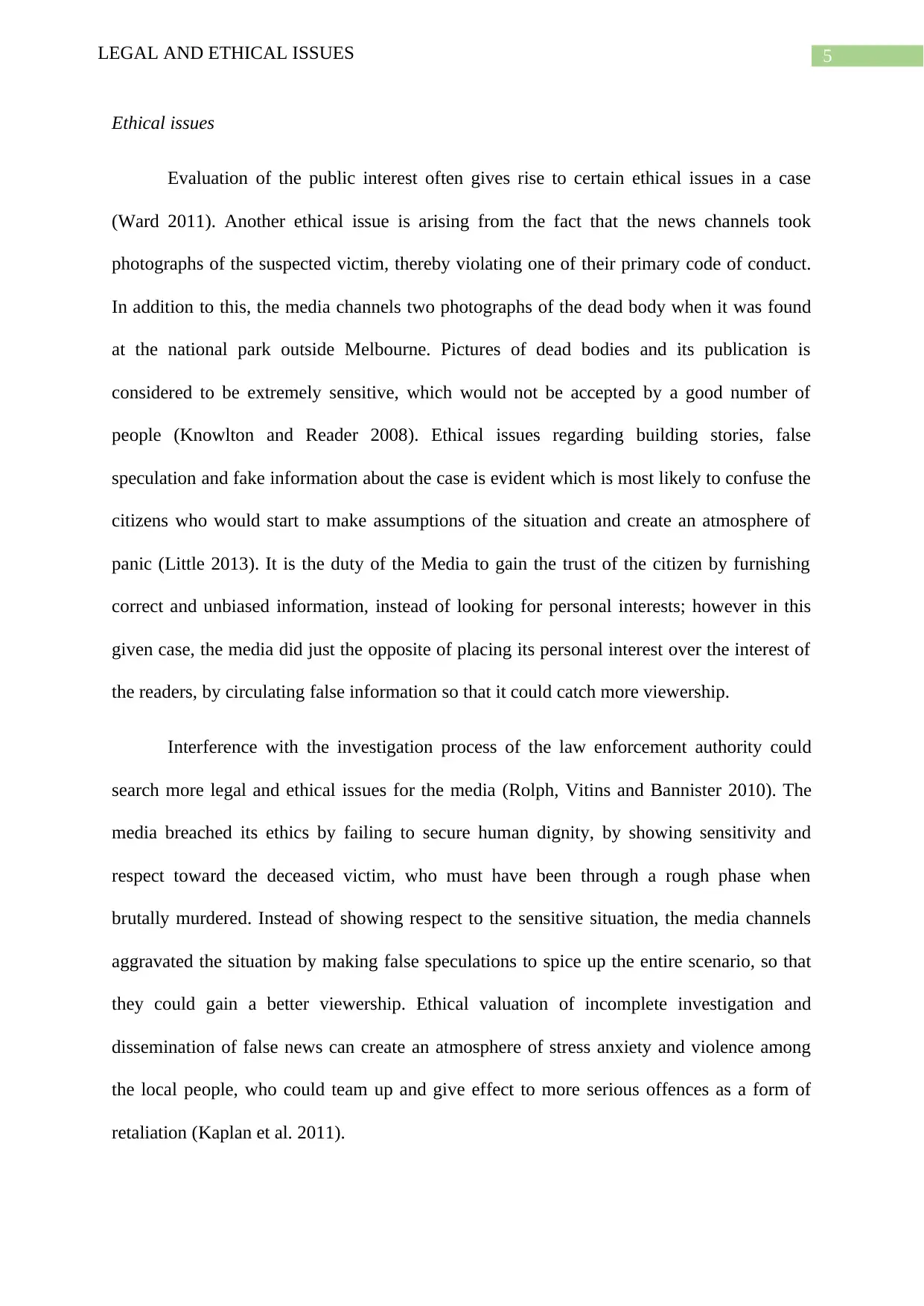
5LEGAL AND ETHICAL ISSUES
Ethical issues
Evaluation of the public interest often gives rise to certain ethical issues in a case
(Ward 2011). Another ethical issue is arising from the fact that the news channels took
photographs of the suspected victim, thereby violating one of their primary code of conduct.
In addition to this, the media channels two photographs of the dead body when it was found
at the national park outside Melbourne. Pictures of dead bodies and its publication is
considered to be extremely sensitive, which would not be accepted by a good number of
people (Knowlton and Reader 2008). Ethical issues regarding building stories, false
speculation and fake information about the case is evident which is most likely to confuse the
citizens who would start to make assumptions of the situation and create an atmosphere of
panic (Little 2013). It is the duty of the Media to gain the trust of the citizen by furnishing
correct and unbiased information, instead of looking for personal interests; however in this
given case, the media did just the opposite of placing its personal interest over the interest of
the readers, by circulating false information so that it could catch more viewership.
Interference with the investigation process of the law enforcement authority could
search more legal and ethical issues for the media (Rolph, Vitins and Bannister 2010). The
media breached its ethics by failing to secure human dignity, by showing sensitivity and
respect toward the deceased victim, who must have been through a rough phase when
brutally murdered. Instead of showing respect to the sensitive situation, the media channels
aggravated the situation by making false speculations to spice up the entire scenario, so that
they could gain a better viewership. Ethical valuation of incomplete investigation and
dissemination of false news can create an atmosphere of stress anxiety and violence among
the local people, who could team up and give effect to more serious offences as a form of
retaliation (Kaplan et al. 2011).
Ethical issues
Evaluation of the public interest often gives rise to certain ethical issues in a case
(Ward 2011). Another ethical issue is arising from the fact that the news channels took
photographs of the suspected victim, thereby violating one of their primary code of conduct.
In addition to this, the media channels two photographs of the dead body when it was found
at the national park outside Melbourne. Pictures of dead bodies and its publication is
considered to be extremely sensitive, which would not be accepted by a good number of
people (Knowlton and Reader 2008). Ethical issues regarding building stories, false
speculation and fake information about the case is evident which is most likely to confuse the
citizens who would start to make assumptions of the situation and create an atmosphere of
panic (Little 2013). It is the duty of the Media to gain the trust of the citizen by furnishing
correct and unbiased information, instead of looking for personal interests; however in this
given case, the media did just the opposite of placing its personal interest over the interest of
the readers, by circulating false information so that it could catch more viewership.
Interference with the investigation process of the law enforcement authority could
search more legal and ethical issues for the media (Rolph, Vitins and Bannister 2010). The
media breached its ethics by failing to secure human dignity, by showing sensitivity and
respect toward the deceased victim, who must have been through a rough phase when
brutally murdered. Instead of showing respect to the sensitive situation, the media channels
aggravated the situation by making false speculations to spice up the entire scenario, so that
they could gain a better viewership. Ethical valuation of incomplete investigation and
dissemination of false news can create an atmosphere of stress anxiety and violence among
the local people, who could team up and give effect to more serious offences as a form of
retaliation (Kaplan et al. 2011).
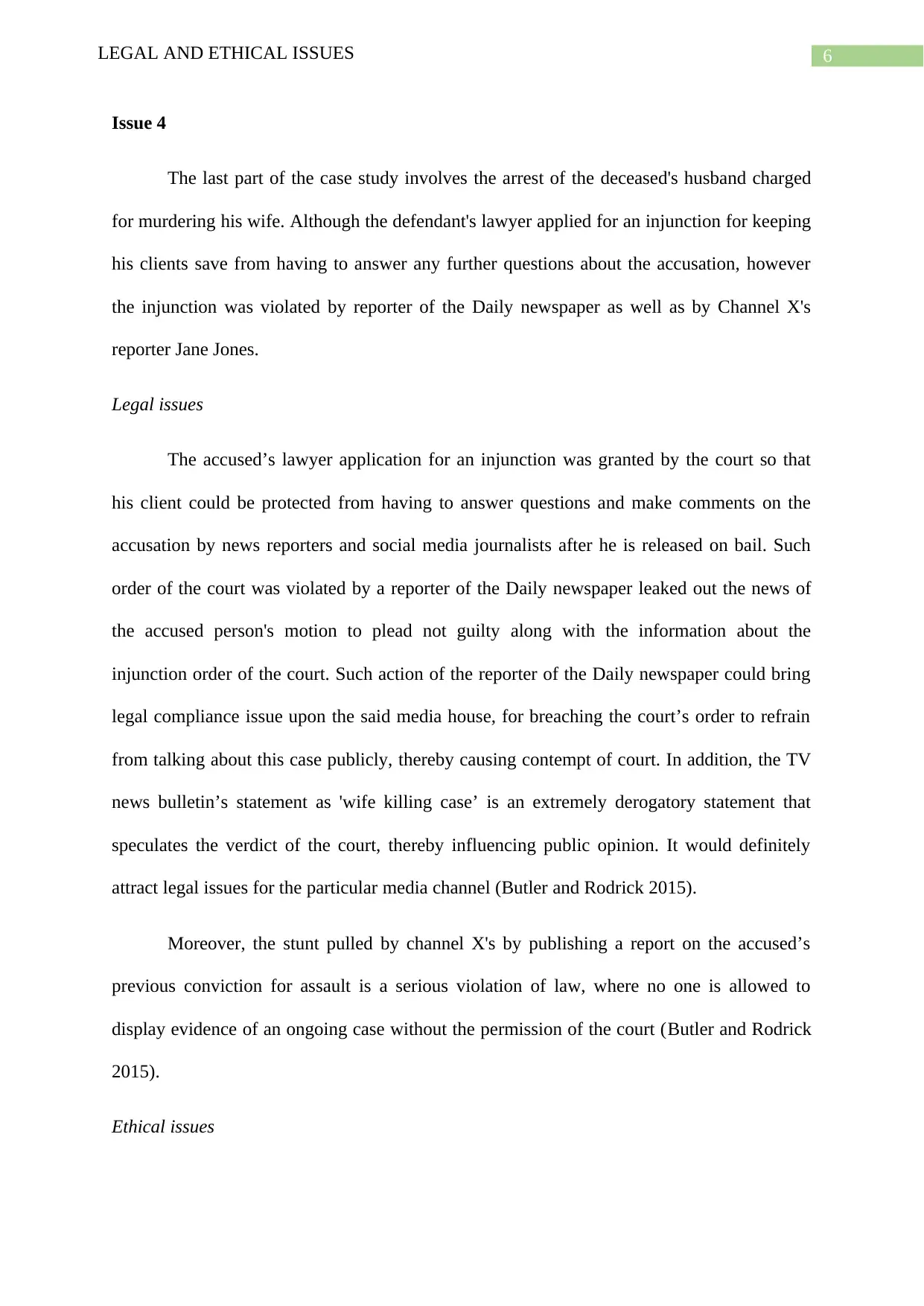
6LEGAL AND ETHICAL ISSUES
Issue 4
The last part of the case study involves the arrest of the deceased's husband charged
for murdering his wife. Although the defendant's lawyer applied for an injunction for keeping
his clients save from having to answer any further questions about the accusation, however
the injunction was violated by reporter of the Daily newspaper as well as by Channel X's
reporter Jane Jones.
Legal issues
The accused’s lawyer application for an injunction was granted by the court so that
his client could be protected from having to answer questions and make comments on the
accusation by news reporters and social media journalists after he is released on bail. Such
order of the court was violated by a reporter of the Daily newspaper leaked out the news of
the accused person's motion to plead not guilty along with the information about the
injunction order of the court. Such action of the reporter of the Daily newspaper could bring
legal compliance issue upon the said media house, for breaching the court’s order to refrain
from talking about this case publicly, thereby causing contempt of court. In addition, the TV
news bulletin’s statement as 'wife killing case’ is an extremely derogatory statement that
speculates the verdict of the court, thereby influencing public opinion. It would definitely
attract legal issues for the particular media channel (Butler and Rodrick 2015).
Moreover, the stunt pulled by channel X's by publishing a report on the accused’s
previous conviction for assault is a serious violation of law, where no one is allowed to
display evidence of an ongoing case without the permission of the court (Butler and Rodrick
2015).
Ethical issues
Issue 4
The last part of the case study involves the arrest of the deceased's husband charged
for murdering his wife. Although the defendant's lawyer applied for an injunction for keeping
his clients save from having to answer any further questions about the accusation, however
the injunction was violated by reporter of the Daily newspaper as well as by Channel X's
reporter Jane Jones.
Legal issues
The accused’s lawyer application for an injunction was granted by the court so that
his client could be protected from having to answer questions and make comments on the
accusation by news reporters and social media journalists after he is released on bail. Such
order of the court was violated by a reporter of the Daily newspaper leaked out the news of
the accused person's motion to plead not guilty along with the information about the
injunction order of the court. Such action of the reporter of the Daily newspaper could bring
legal compliance issue upon the said media house, for breaching the court’s order to refrain
from talking about this case publicly, thereby causing contempt of court. In addition, the TV
news bulletin’s statement as 'wife killing case’ is an extremely derogatory statement that
speculates the verdict of the court, thereby influencing public opinion. It would definitely
attract legal issues for the particular media channel (Butler and Rodrick 2015).
Moreover, the stunt pulled by channel X's by publishing a report on the accused’s
previous conviction for assault is a serious violation of law, where no one is allowed to
display evidence of an ongoing case without the permission of the court (Butler and Rodrick
2015).
Ethical issues
Paraphrase This Document
Need a fresh take? Get an instant paraphrase of this document with our AI Paraphraser
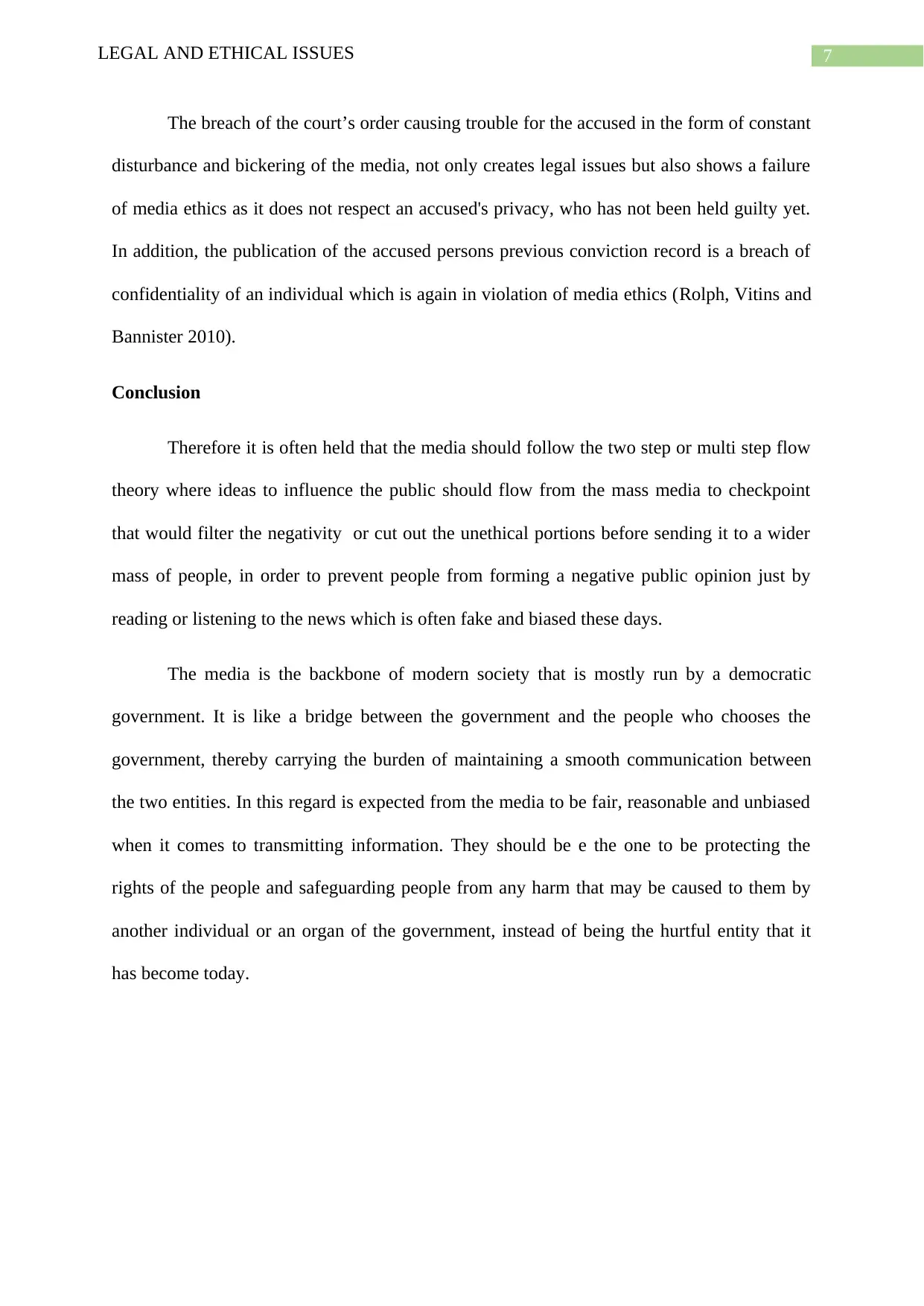
7LEGAL AND ETHICAL ISSUES
The breach of the court’s order causing trouble for the accused in the form of constant
disturbance and bickering of the media, not only creates legal issues but also shows a failure
of media ethics as it does not respect an accused's privacy, who has not been held guilty yet.
In addition, the publication of the accused persons previous conviction record is a breach of
confidentiality of an individual which is again in violation of media ethics (Rolph, Vitins and
Bannister 2010).
Conclusion
Therefore it is often held that the media should follow the two step or multi step flow
theory where ideas to influence the public should flow from the mass media to checkpoint
that would filter the negativity or cut out the unethical portions before sending it to a wider
mass of people, in order to prevent people from forming a negative public opinion just by
reading or listening to the news which is often fake and biased these days.
The media is the backbone of modern society that is mostly run by a democratic
government. It is like a bridge between the government and the people who chooses the
government, thereby carrying the burden of maintaining a smooth communication between
the two entities. In this regard is expected from the media to be fair, reasonable and unbiased
when it comes to transmitting information. They should be e the one to be protecting the
rights of the people and safeguarding people from any harm that may be caused to them by
another individual or an organ of the government, instead of being the hurtful entity that it
has become today.
The breach of the court’s order causing trouble for the accused in the form of constant
disturbance and bickering of the media, not only creates legal issues but also shows a failure
of media ethics as it does not respect an accused's privacy, who has not been held guilty yet.
In addition, the publication of the accused persons previous conviction record is a breach of
confidentiality of an individual which is again in violation of media ethics (Rolph, Vitins and
Bannister 2010).
Conclusion
Therefore it is often held that the media should follow the two step or multi step flow
theory where ideas to influence the public should flow from the mass media to checkpoint
that would filter the negativity or cut out the unethical portions before sending it to a wider
mass of people, in order to prevent people from forming a negative public opinion just by
reading or listening to the news which is often fake and biased these days.
The media is the backbone of modern society that is mostly run by a democratic
government. It is like a bridge between the government and the people who chooses the
government, thereby carrying the burden of maintaining a smooth communication between
the two entities. In this regard is expected from the media to be fair, reasonable and unbiased
when it comes to transmitting information. They should be e the one to be protecting the
rights of the people and safeguarding people from any harm that may be caused to them by
another individual or an organ of the government, instead of being the hurtful entity that it
has become today.
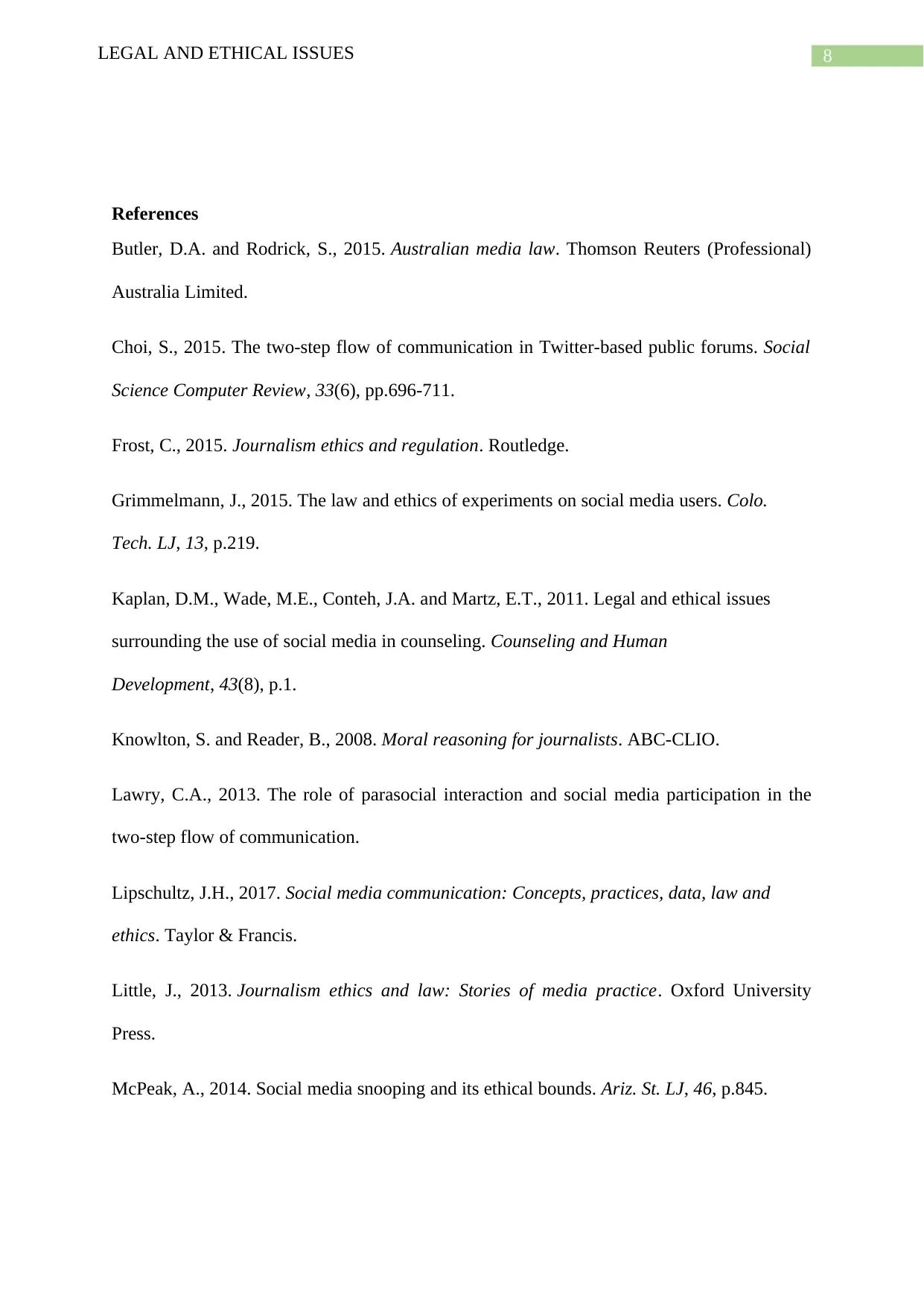
8LEGAL AND ETHICAL ISSUES
References
Butler, D.A. and Rodrick, S., 2015. Australian media law. Thomson Reuters (Professional)
Australia Limited.
Choi, S., 2015. The two-step flow of communication in Twitter-based public forums. Social
Science Computer Review, 33(6), pp.696-711.
Frost, C., 2015. Journalism ethics and regulation. Routledge.
Grimmelmann, J., 2015. The law and ethics of experiments on social media users. Colo.
Tech. LJ, 13, p.219.
Kaplan, D.M., Wade, M.E., Conteh, J.A. and Martz, E.T., 2011. Legal and ethical issues
surrounding the use of social media in counseling. Counseling and Human
Development, 43(8), p.1.
Knowlton, S. and Reader, B., 2008. Moral reasoning for journalists. ABC-CLIO.
Lawry, C.A., 2013. The role of parasocial interaction and social media participation in the
two-step flow of communication.
Lipschultz, J.H., 2017. Social media communication: Concepts, practices, data, law and
ethics. Taylor & Francis.
Little, J., 2013. Journalism ethics and law: Stories of media practice. Oxford University
Press.
McPeak, A., 2014. Social media snooping and its ethical bounds. Ariz. St. LJ, 46, p.845.
References
Butler, D.A. and Rodrick, S., 2015. Australian media law. Thomson Reuters (Professional)
Australia Limited.
Choi, S., 2015. The two-step flow of communication in Twitter-based public forums. Social
Science Computer Review, 33(6), pp.696-711.
Frost, C., 2015. Journalism ethics and regulation. Routledge.
Grimmelmann, J., 2015. The law and ethics of experiments on social media users. Colo.
Tech. LJ, 13, p.219.
Kaplan, D.M., Wade, M.E., Conteh, J.A. and Martz, E.T., 2011. Legal and ethical issues
surrounding the use of social media in counseling. Counseling and Human
Development, 43(8), p.1.
Knowlton, S. and Reader, B., 2008. Moral reasoning for journalists. ABC-CLIO.
Lawry, C.A., 2013. The role of parasocial interaction and social media participation in the
two-step flow of communication.
Lipschultz, J.H., 2017. Social media communication: Concepts, practices, data, law and
ethics. Taylor & Francis.
Little, J., 2013. Journalism ethics and law: Stories of media practice. Oxford University
Press.
McPeak, A., 2014. Social media snooping and its ethical bounds. Ariz. St. LJ, 46, p.845.
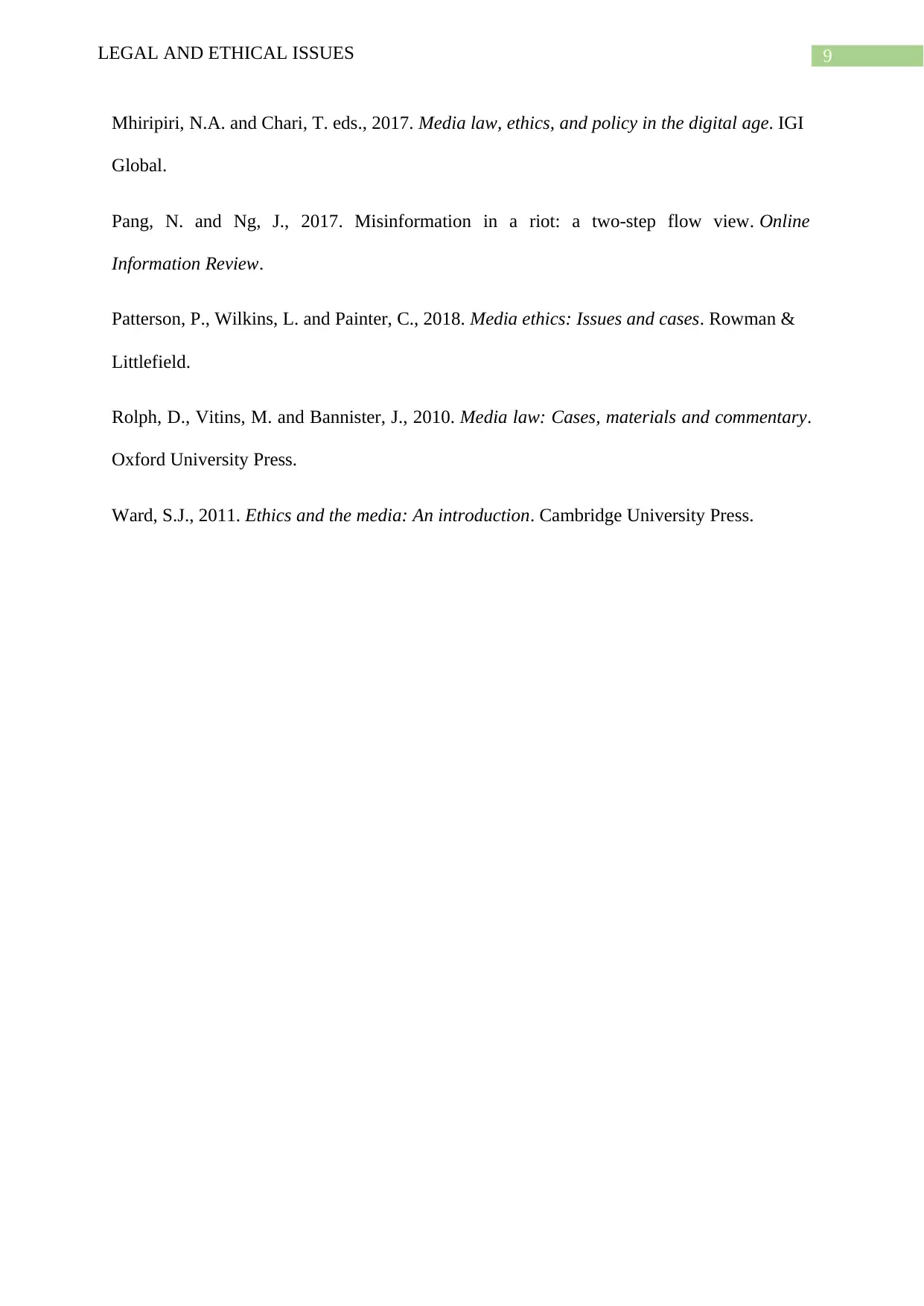
9LEGAL AND ETHICAL ISSUES
Mhiripiri, N.A. and Chari, T. eds., 2017. Media law, ethics, and policy in the digital age. IGI
Global.
Pang, N. and Ng, J., 2017. Misinformation in a riot: a two-step flow view. Online
Information Review.
Patterson, P., Wilkins, L. and Painter, C., 2018. Media ethics: Issues and cases. Rowman &
Littlefield.
Rolph, D., Vitins, M. and Bannister, J., 2010. Media law: Cases, materials and commentary.
Oxford University Press.
Ward, S.J., 2011. Ethics and the media: An introduction. Cambridge University Press.
Mhiripiri, N.A. and Chari, T. eds., 2017. Media law, ethics, and policy in the digital age. IGI
Global.
Pang, N. and Ng, J., 2017. Misinformation in a riot: a two-step flow view. Online
Information Review.
Patterson, P., Wilkins, L. and Painter, C., 2018. Media ethics: Issues and cases. Rowman &
Littlefield.
Rolph, D., Vitins, M. and Bannister, J., 2010. Media law: Cases, materials and commentary.
Oxford University Press.
Ward, S.J., 2011. Ethics and the media: An introduction. Cambridge University Press.
1 out of 10
Related Documents
Your All-in-One AI-Powered Toolkit for Academic Success.
+13062052269
info@desklib.com
Available 24*7 on WhatsApp / Email
![[object Object]](/_next/static/media/star-bottom.7253800d.svg)
Unlock your academic potential
© 2024 | Zucol Services PVT LTD | All rights reserved.




